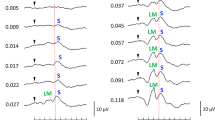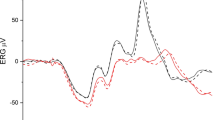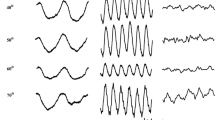Abstract
The aim of this study was to differentiate S-cone responses from other retinal activities using various recording conditions and to optimize these recording conditions for clinical diagnostics. S-cone responses to blue stimuli (449 nm) were studied in 20 healthy subjects and four patients with enhanced S-cone syndrome. The time-integrated luminance of the stimulus varied from 0.008 to 1.0 cd s/m2. Three isoluminant backgrounds were used (100 ph cd/m2 = 40 sc cd/m2): amber (594 nm), green (513 nm), and red (635 nm). With low flash strengths (from 0.008 to 0.032 cd s/m2), the S-cone response appeared as a single positive peak, while with higher strengths (≥0.064 cd s/m2), it appeared as a second peak that followed the L-cone and M-cone components. With a further increase in flash strength (≥0.25 cd s/m2), the S-cone response interfered with the i-wave of the L-cone and M-cone systems. The wavelength and luminance of the background influenced the suppression of the rods, as well as the L-cone- and M-cone-system activities. The S-cone response was measurable in the presence of the amber and green backgrounds, but its amplitude was higher if a strong red background was used. Thus, the function of the retinal S-cone system can be measured if possible interference from other retinal sources can be minimized by the appropriate combination of stimulus and background parameters.







Similar content being viewed by others
References
Norren DV, Padmos P (1973) Human and macaque blue cones studied with electroretinography. Vis Res 13(7):1241–1254
Gouras P, MacKay CJ (1990) Electroretinographic responses of the short-wavelength-sensitive cones. Invest Ophthalmol Vis Sci 31(7):1203–1209
Gouras P, MacKay CJ, Yamamoto S (1993) The human S-cone electroretinogram and its variation among subjects with and without L and M-cone function. Invest Ophthalmol Vis Sci 34(8):2437–2442
Gouras P (2003) The role of S-cones in human vision. Doc Ophthalmol 106(1):5–11
Evers HU, Gouras P (1986) Three cone mechanisms in the primate electroretinogram: two with, one without off-center bipolar responses. Vis Res 26(2):245–254
Padmos P, van Norren D, Faijer JW (1978) Blue cone function in a family with an inherited tritan defect, tested with electroretinography and psychophysics. Invest Ophthalmol Vis Sci 17(5):436–441
Román AJ, Jacobson SG (1991) S cone-driven but not S cone-type electroretinograms in the enhanced S cone syndrome. Exp Eye Res 53(5):685–690
Swanson WH, Birch DG, Anderson JL (1993) S-cone function in patients with retinitis pigmentosa. Invest Ophthalmol Vis Sci 34(11):3045–3055
Yamamoto S, Kataoka Y, Kamiyama M, Hayasaka S (1995) Nondetectable S-cone electroretinogram in a patient with crystalline retinopathy. Doc Ophthalmol 90(3):221–227
Yamamoto S, Kamiyama M, Nitta K, Yamada T, Hayasaka S (1996) Selective reduction of the S cone electroretinogram in diabetes. Br J Ophthalmol 80(11):973–975
Simonsen SE, Rosenberg T (1995–1996) Reappraisal of a short-wavelength-sensitive (S-cone) recording technique in routine clinical electroretinography. Doc Ophthalmol 91(4):323–332
Yamamoto S, Hayashi M, Takeuchi S, Shirao Y, Kita K, Kawasaki K (1997) Normal S cone electroretinogram b-wave in Oguchi’s disease. Br J Ophthalmol 81(12):1043–1045
Arden G, Wolf J, Berninger T, Hogg CR, Tzekov R, Holder GE (1999) S-cone ERGs elicited by a simple technique in normals and in tritanopes. Vis Res 39(3):641–650
Yamamoto S, Hayashi M, Takeuchi S (1999) S-cone electroretinogram to Ganzfeld stimuli in patients with retinitis pigmentosa. Doc Ophthalmol 99(2):183–189
Yamamoto S, Hayashi M, Tsuruoka M, Ogata K, Tsukahara I, Yamamoto T, Takeuchi S (2002) Selective reduction of S-cone response and on-response in the cone electroretinograms of patients with X-linked retinoschisis. Graefes Arch Clin Exp Ophthalmol 240(6):457–460
Chiti F, Stefani M, Taddei N, Ramponi G, Dobson CM (2003) Rationalization of the effects of mutations on peptide and protein aggregation rates. Nature 424(6950):805–808
Marmor M, Cabael L, Shukla S, Hwang JC, Marcus M (2004) Clinical S-cone ERG recording with a commercial hand-held full-field stimulator. Doc Ophthalmol 109(1):101–107
Audo I, Michaelides M, Robson AG, Hawlina M, Vaclavik V, Sandbach JM, Neveu MM, Hogg CR, Hunt DM, Moore AT, Bird AC, Webster AR, Holder GE (2008) Phenotypic variation in enhanced S-cone syndrome. Invest Ophthalmol Vis Sci 49(5):2082–2093
Hawlina M, Konec B (1992) New noncorneal HK-loop electrode for clinical electroretinography. Doc Ophthalmol 81(2):253–259
Stockman A, Sharpe LT (2000) Spectral sensitivities of the middle- and long-wavelength sensitive cones derived from measurements in observers of known genotype. Vis Res 40:1711–1737
Thomas MM, Lamb TD (1999) Light adaptation and dark adaptation of human rod photoreceptors measured from the a-wave of the electroretinogram. J Physiol 518:479–496
Horiguchi M, Miyake Y, Kondo M, Suzuki S, Tanikawa A, Koo HM (1995) Blue light-emitting diode built-in contact lens electrode can record human S-cone electroretinogram. Invest Ophthalmol Vis Sci 36(8):1730–1732
Sawusch M, Pokorny J, Smith VC (1987) Clinical electroretinography for short wavelength sensitive cones. Invest Ophthalmol Vis Sci 28(6):966–974
Nilsson A, Wright T, Westall CA (2008) A promising S-cone isolating protocol. Doc Ophthalmol 117(supl):40–41
Sharpe LT, Stockman A (1999) Rod pathways: the importance of seeing nothing. Trends Neurosci 22(11):497–504
Stockman A, Sharpe LT, Zrenner E, Nordby K (1991) Slow and fast pathways in the human rod visual system: electrophysiology and psychophysics. J Opt Soc Am A 8(10):1657–1665
Glickman RD (2002) Phototoxicity to the retina: mechanisms of damage. Int J Toxicol 21(6):473–490
Zrenner E, Gouras P (1979) Blue-sensitive cones of the cat produce a rodlike electroretinogram. Invest Ophthalmol Vis Sci 18(10):1076–1081
Rangaswamy NV, Frishman LJ, Dorotheo EU, Schiffman JS, Bahrani HM, Tang RA (2004) Photopic ERGs in patients with optic neuropathies: comparison with primate ERGs after pharmacologic blockade of inner retina. Invest Ophthalmol Vis Sci 45(10):3827–3837
Rufiange M, Dumont M, Lachapelle P (2005) Modulation of the human photopic ERG luminance-response function with the use of chromatic stimuli. Vis Res 45(17):2321–2330
Ueno S, Kondo M, Ueno M, Miyata K, Terasaki H, Miyake Y (2006) Contribution of retinal neurons to d-wave of primate photopic electroretinograms. Vis Res 46(5):658–664
Jacobson SG, Marmor MF, Kemp CM, Knighton RW (1990) SWS (blue) cone hypersensitivity in a newly identified retinal degeneration. Invest Ophthalmol Vis Sci 31(5):827–838
Greenstein VC, Zaidi Q, Hood DC, Spehar B, Cideciyan AV, Jacobson SG (1996) The enhanced S cone syndrome: an analysis of receptoral and post-receptoral changes. Vis Res 36(22):3711–3722
Lam BL, Goldberg JL, Hartley KL, Stone EM, Liu M (2007) Atypical mild enhanced S-cone syndrome with novel compound heterozygosity of the NR2E3 gene. Am J Ophthalmol 144(1):157–159
Marmor MF, Tan F, Sutter EE, Bearse MA Jr (1999) Topography of cone electrophysiology in the enhanced S cone syndrome. Invest Ophthalmol Vis Sci 40(8):1866–1873
Acknowledgments
The authors thank Mrs. Marija Jesenšek and Mrs. Ana Jeršin, who were involved in the clinical ERG recording. This study was supported by Slovenian Research Agency, Grant No. J3-6167 and P3-0333.
Author information
Authors and Affiliations
Corresponding author
Rights and permissions
About this article
Cite this article
Sustar, M., Hawlina, M. & Brecelj, J. Electroretinographic evaluation of the retinal S-cone system. Doc Ophthalmol 123, 199–210 (2011). https://doi.org/10.1007/s10633-011-9299-5
Received:
Accepted:
Published:
Issue Date:
DOI: https://doi.org/10.1007/s10633-011-9299-5




